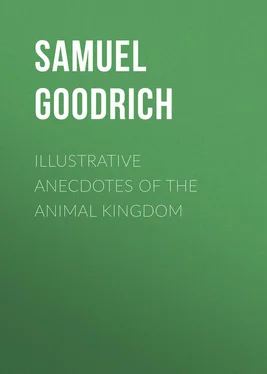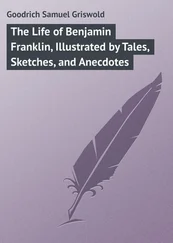Samuel Goodrich - Illustrative Anecdotes of the Animal Kingdom
Здесь есть возможность читать онлайн «Samuel Goodrich - Illustrative Anecdotes of the Animal Kingdom» — ознакомительный отрывок электронной книги совершенно бесплатно, а после прочтения отрывка купить полную версию. В некоторых случаях можно слушать аудио, скачать через торрент в формате fb2 и присутствует краткое содержание. Жанр: Природа и животные, foreign_prose, на английском языке. Описание произведения, (предисловие) а так же отзывы посетителей доступны на портале библиотеки ЛибКат.
- Название:Illustrative Anecdotes of the Animal Kingdom
- Автор:
- Жанр:
- Год:неизвестен
- ISBN:нет данных
- Рейтинг книги:3 / 5. Голосов: 1
-
Избранное:Добавить в избранное
- Отзывы:
-
Ваша оценка:
- 60
- 1
- 2
- 3
- 4
- 5
Illustrative Anecdotes of the Animal Kingdom: краткое содержание, описание и аннотация
Предлагаем к чтению аннотацию, описание, краткое содержание или предисловие (зависит от того, что написал сам автор книги «Illustrative Anecdotes of the Animal Kingdom»). Если вы не нашли необходимую информацию о книге — напишите в комментариях, мы постараемся отыскать её.
Illustrative Anecdotes of the Animal Kingdom — читать онлайн ознакомительный отрывок
Ниже представлен текст книги, разбитый по страницам. Система сохранения места последней прочитанной страницы, позволяет с удобством читать онлайн бесплатно книгу «Illustrative Anecdotes of the Animal Kingdom», без необходимости каждый раз заново искать на чём Вы остановились. Поставьте закладку, и сможете в любой момент перейти на страницу, на которой закончили чтение.
Интервал:
Закладка:
HEDGEHOG
This animal belongs exclusively to the eastern continent, and is well known from the thick and sharp prickles with which its back and sides are covered, and the contractile power by which it can draw its head and belly within the prickly covering of its back, so as to give it the appearance of a ball. It is found near hedges and thickets, from the fruits and herbage of which it obtains its food. It also feeds upon small animals, such as snails and beetles.
The sagacity of the hedgehog is celebrated in antiquity. We are informed by Plutarch, that a citizen of Cyzicus thus acquired the reputation of a good meteorologist: A hedgehog generally has its burrow open in various points; and, when its instinct warns it of an approaching change of the wind, it stops up the aperture towards that quarter. The citizen alluded to, becoming aware of this practice, was able to predict to what point the wind would next shift.
Though of a very timid disposition, the hedgehog has been sometimes tamed. In the year 1790, there was one in the possession of a Mr. Sample, in Northumberland, which performed the duty of a turnspit as well, in all respects, as the dog of that denomination. It ran about the house with the same familiarity as any other domestic animal.
In the London Sporting Magazine for 1821, there is an account of one, which, after having been tamed in a garden, found its way to the scullery, and there made regular search for the relics of the dinner plates; having its retreat in the adjoining cellar. It was fed after the manner itself had selected. Milk was given in addition to the meat; but it lost its relish for vegetables, and constantly rejected them. It soon became as well domesticated as the cat, and lived on a footing of intimacy with it.
THE MOLE
Of this animal there are several species; they burrow in the earth, and form avenues from one nest to another, like the crossing streets of a city. Their eyes are small, and so buried in fur as to be invisible, except on close inspection.
Mole-Catching. – It has been a common opinion that moles were destructive to the crops; and in Europe, much pains have been taken to destroy them. The mole-catcher – in general a quiet old man, who passes his winter in making his traps, in the chimney-corner – comes forth, in the spring, with his implements of destruction. His practised eye soon discovers the tracks of the mole, from the mound which he throws up to some neighboring bank, or from one mound to another. It is in this track, or run, that he sets his trap, a few inches below the surface of the ground. As the mole passes through this little engine of his ruin, he disturbs a peg which holds down a strong hazel rod in a bent position. The moment the peg is moved, the end of the rod which is held down flies up, and with it comes up the poor mole, dragged out of the earth which he has so ingeniously excavated, to be gibbeted, without a chance of escape.
There was a Frenchman, of the name of Le Court, who died a few years since, – a man of great knowledge and perseverance, and who did not think it beneath him to devote his whole attention to the observation of the mole. He established a school for mole-catching; and taught many what he had acquired by incessant perseverance – the art of tracing the mole to his hiding-place in the ground, and cutting off his retreat. The skill of this man once saved, as was supposed, a large and fertile district of France from inundation by a canal, whose banks the moles had undermined in every direction.
More recently, it has been doubted whether moles are really so mischievous to the farmer as has been supposed. It is said that they assist in draining the land, and thus prevent the foot-rot in sheep. Mr. Hogg, the Ettrick shepherd, says, "If a hundred men and horses were employed on a common-sized pasture-farm – say from 1500 to 2000 acres – in raising and draining manure for a top-dressing to the land, they would not do it so effectually, so equally, and so neatly, as the natural number of moles on the farm would do for themselves."
Moles are said to be very ferocious animals; and, as an evidence of this, we are told that a mole, a toad, and a viper, were enclosed in a glass case; the mole despatched the other two, and devoured a great part of both of them.
THE BEAR
Of this animal there are many species; among which, the white bear of the polar regions, and the grisly bear of the eastern slope of the Rocky Mountains, are the largest and most formidable. The brown bear is common to both continents. The most remarkable of the other species are the Bornean, spectacled, large-lipped, Thibetian, and Malayan.
The Brown or Black Bear. — Miscellaneous Anecdotes. – This species, like the rest of the family, is a solitary animal; for he only remains associated with his mate for a short period, and then retires to his winter retreat, which is usually in the hole of a rock, the cavity of a tree, or a pit in the earth, which the animal frequently digs for himself. He sometimes constructs a kind of hut, composed of the branches of trees, which he lines with moss. In these situations he continues, for the most part, in a lethargic state, taking no food, but subsisting entirely on the absorption of the fat which he has accumulated in the course of the summer.
The modes that are adopted, by the inhabitants of different countries, for taking or destroying bears, are various. Of these, the following appear to be the most remarkable: In consequence of the well-known partiality of these animals for honey, the Russians sometimes fix to those trees where bees are hived a heavy log of wood, at the end of a long string. When the unwieldy creature climbs up, to get at the hive, he finds himself interrupted by the log; he pushes it aside, and attempts to pass it; but, in returning, it hits him such a blow, that, in a rage, he flings it from him with greater force, which makes it return with increased violence; and he sometimes continues this, till he is either killed, or falls from the tree.
In Lapland, hunting the bear is often undertaken by a single man, who, having discovered the retreat of the animal, takes his dog along with him, and advances towards the spot. The jaws are tied round with a cord, to prevent his barking; and the man holds the other end of this cord in his hand. As soon as the dog smells the bear, he begins to show signs of uneasiness, and, by dragging at the cord, informs his master that the object of his pursuit is at no great distance.
When the Laplander, by this means, discovers on which side the bear is stationed, he advances in such a direction that the wind may blow from the bear to him, and not the contrary; for otherwise, the animal would, by his scent, be aware of his approach, though not able to see the enemy, being blinded by sunshine. The olfactory organs of the bear are exquisite. When the hunter has advanced to within gunshot of the bear, he fires upon him; and this is very easily accomplished in autumn, as he is then more fearless, and is constantly prowling about for berries of different kinds, on which he feeds at this season of the year. Should the man chance to miss his aim, the furious beast will directly turn upon him in a rage, and the little Laplander is obliged to take to his heels with all possible speed, leaving his knapsack behind him on the spot. The bear, coming up to this, seizes upon it, biting and tearing it into a thousand pieces. While he is thus venting his fury, the Laplander, who is generally a good marksman, reloads his gun, and usually destroys him at the second shot; if not, the bear in most cases runs away.
Bear-baiting was a favorite amusement of our English ancestors. Sir Thomas Pope entertained Queen Mary and the Princess Elizabeth, at Hatfield, with a grand exhibition of a "bear-baiting, with which their highnesses were right well content." Bear-baiting was part of the amusement of Elizabeth, among "the princely pleasures of Kenilworth Castle." Rowland White, speaking of the queen, then in her sixty-seventh year, says, – "Her majesty is very well. This day she appoints a Frenchman to do feats upon a rope, in the Conduit Court. To-morrow she has commanded the bears, the bull, and the ape, to be bayted, in the tilt-yard. Upon Wednesday, she will have solemn dauncing." The office of chief master of the bear was held under the crown, with a salary of 16d. per diem . Whenever the king chose to entertain himself or his visitors with this sport, it was the duty of the master to provide bears and dogs, and to superintend the baiting; and he was invested with unlimited authority to issue commissions, and to send his officers into every county in England, who were empowered to seize and take away any bears, bulls, or dogs, that they thought meet, for his majesty's service. The latest record, by which this diversion was publicly authorized, is a grant to Sir Saunders Duncombe, October 11, 1561, "for the sole practice and profit of the fighting and combating of wild and domestic beasts, within the realm of England, for the space of fourteen years." Occasional exhibitions of this kind were continued till about the middle of the eighteenth century.
Читать дальшеИнтервал:
Закладка:
Похожие книги на «Illustrative Anecdotes of the Animal Kingdom»
Представляем Вашему вниманию похожие книги на «Illustrative Anecdotes of the Animal Kingdom» списком для выбора. Мы отобрали схожую по названию и смыслу литературу в надежде предоставить читателям больше вариантов отыскать новые, интересные, ещё непрочитанные произведения.
Обсуждение, отзывы о книге «Illustrative Anecdotes of the Animal Kingdom» и просто собственные мнения читателей. Оставьте ваши комментарии, напишите, что Вы думаете о произведении, его смысле или главных героях. Укажите что конкретно понравилось, а что нет, и почему Вы так считаете.












